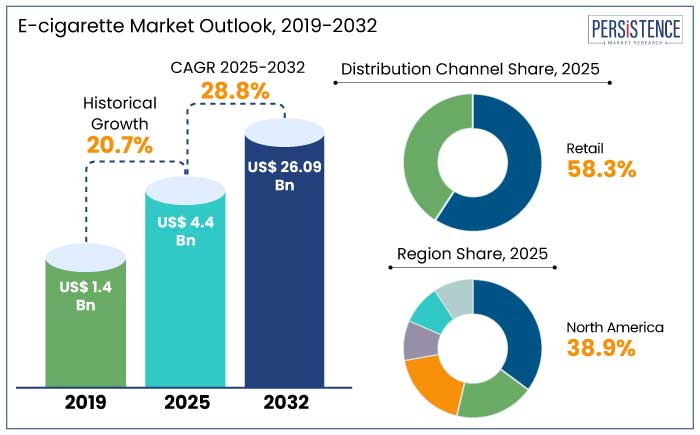Industry: Consumer Goods
Published Date: January-2025
Format: PPT*, PDF, EXCEL
Delivery Timelines: Contact Sales
Number of Pages: 194
Report ID: PMRREP33555
The global e-cigarette market is estimated to reach a size of US$ 4.4 Bn in 2025. It is predicted to rise at a CAGR of 28.8% through the assessment period to attain a value of US$ 26.09 Bn by 2032.
Demand for e-cigarettes and vapes is estimated to be driven by the perception of e-cigarettes as safer alternatives to traditional smoking, particularly among the younger demographic. Integration of modern technology like pod systems and squonk mods propelled the worldwide sales of e-cigarettes to 9.5% growth in 2023, with North America and Europe leading the way in adoption rates.
The global pandemic reshaped marketing strategies, with companies like JUUL Labs leveraging online platforms to increase sales while promoting flavors like menthol, fruits, and tobacco.
In order to secure sustainable growth, the market is adjusting to obstacles such as trade limits and regulatory scrutiny by concentrating on heightened control.

Key Highlights of the Market
|
Market Attributes |
Key Insights |
|
E-cigarette Market Size (2025E) |
US$ 4.4 Bn |
|
Projected Market Value (2032F) |
US$ 26.09 Bn |
|
Global Market Growth Rate (CAGR 2025 to 2032) |
28.8% |
|
Historical Market Growth Rate (CAGR 2019 to 2023) |
20.7% |
North America is likely to hold a market share of 38.9% in 2025. The region is estimated to witness a CAGR of 6.4% from 2025 to 2032, driven by the diverse range of flavors and customization options available. Flavors like fruit, dessert, menthol, and beverages continue to attract a broad audience, including young adults and non-smokers seeking a safer alternative to traditional cigarettes. For example,
Adoption of vaping devices among younger generations highlights North America’s place in innovation and market influence despite regulatory challenges.
The e-cigarette market in Europe is booming, with 32.1% of the global share in 2025 and a CAGR of 7.2% from 2025 to 2032. Sales of e-cigarettes increased by 10% across Europe in 2023, with the U.K., Germany, and France leading the way in adoption as harm reduction and lifestyle-focused vaping became more popular post-pandemic.
Such innovations, coupled with an emphasis on safety and exclusivity, ensure Europe’s continued growth as a key player on a global scale.
The rechargeable e-cigarette segment is projected to dominate the market in 2025, accounting for 42.6% of the total share. This is driven by its high portability, convenience, and cost-effectiveness compared to disposable alternatives.
Manufacturers' emphasis on user experience innovation propelled the worldwide sales of rechargeable e-cigarettes. These enable consumers to personalize performance parameters like nicotine strength and vapor generation, to an 11% increase in 2023. For instance,
Demand for e-cigarettes is predicted to be dominated by the rechargeable segment due to specialized developments and customer desire for reusable, environmentally friendly vaping products.
In 2025, the retail distribution channel is predicted to account for 58.3% of the market share, due to its accessibility through brick-and-mortar stores, convenience outlets, and specialty vape shops. Retail stores provide customers with personalized experiences, leading to market growth. In 2023, e-cigarette sales increased by 9% due to in-person shopping, as per studies.
Retail channels continue to dominate the e-cigarette market, emphasizing their role in consumer engagement, trust building, and product availability.
The vaping device and e-cigarette market is anticipated to be propelled by innovations in design and rising health awareness in developing countries. Features such as temperature control, Bluetooth connectivity, and app integration are enhancing user experience and driving the adoption of e-cigarettes.
Launch of unique flavor options like tropical fruits and desserts attract younger demographics, raising regulatory scrutiny, particularly in North America and Europe. Online retail channels and social media platforms amplify product awareness, while strict tobacco regulations push smokers toward e-cigarettes, reshaping the market's landscape.

The global e-cigarettes market recorded a CAGR of 20.7% in the historical period from 2019 to 2023. Demand for e-cigarettes and vapes in end-use industries increased, but COVID-19 restrictions led to a slight disruption in sales. For example,
Demand for vaping devices like e-cigars is estimated to record a considerable CAGR of 28.8% during the forecast period between 2025 and 2032.
Rising Health Consciousness among Individuals
Health-conscious customers who are worried about secondhand smoke are drawn to e-cigarettes as these produce vapor, making them a less dangerous option than conventional tobacco. Companies like Juul Labs and British American Tobacco (BAT) are leveraging health-focused marketing strategies, including reduced nicotine content and customizable vaping devices, to attract a broader consumer base. For example,
As societal attitudes continue to shift toward healthier lifestyles and the stigma around traditional smoking increases, adoption of e-cigarettes is set to accelerate.
Technical Breakthroughs in Vaping Devices
Specialized innovations in vaping devices are reshaping the industry by enhancing user experience and convenience. Features such as temperature control, Bluetooth connectivity, and app integration are gaining traction, enabling users to customize their vaping preferences and monitor usage patterns. For example,
Bluetooth-enabled devices from SMOK enable real-time usage tracking through smartphone apps, appealing to tech-savvy consumers and new demographics seeking modern alternatives to traditional smoking. These innovations attract existing users and attract new users. As manufacturers continue to invest in research and development, such innovations are set to fuel sustained growth in the global industry.
Regulatory Restrictions May Limit Production of Smoking Devices
Health issues, such as those about safety and effectiveness, present difficulties for the e-cigarette industry. Some people are skeptical of the long-term health effects of e-cigarettes, while others see them as a viable substitute for regular cigarettes.
Exorbitant taxes and tariffs on e-cigarettes may reduce their affordability and deter price-sensitive consumers from using them. Implementing efficient age limitations and access controls, as well as striking a balance between the interests of adult users and the requirement to avoid juvenile beginning, are regulatory obstacles. For instance,
Experimentation with Diverse Flavors Displays Beneficial Prospects
The rising variety of flavors and customization options in e-cigarettes is boosting their appeal, particularly among younger consumers. Flavors ranging from fruity blends to dessert-inspired options, combined with sleek and aesthetically pleasing device designs, have positioned e-cigarettes as a lifestyle product. For instance,
Such efforts are supported by innovative marketing strategies, including collaborations with influencers and celebrity endorsements. For instance,
The FDA and European Union regulators have implemented strict flavor restrictions and advertising guidelines to prevent underage usage of products with a high youth appeal.
Launch of Smoking Cessation Products Shapes Innovation
Companies are being compelled to change their tactics and come up with new ideas as a result of the increasing competition in the e-cigarette industry from heated tobacco substitutes and smoking cessation solutions. Products like nicotine replacement therapies (patches, gums, and lozenges) and heated tobacco devices such as IQOS by Philip Morris International, have gained traction globally. For example,
To remain competitive, e-cigarette companies like JUUL Labs are focusing on product diversification, including lower nicotine variants and improved vapor technology. The market is adapting to consumer demands and regulatory pressures by integrating innovative features like app-connected devices and sustainable packaging.
Market participants in the e-cigarettes industry are making significant investments in research and development to enhance product offerings, such as battery life, flavor variety, and device efficiency. For a more seamless vaping experience, they are additionally adding nicotine salts and other e-liquid compositions to their product line.
To boost brand awareness and appeal to younger audiences, marketing tactics are further being prioritized, with funds going toward influencer collaborations, digital campaigns, and social media presence. This approach seeks to strengthen their position in the market and spur development.
Recent Industry Developments
|
Attributes |
Details |
|
Forecast Period |
2025 to 2032 |
|
Historical Data Available for |
2019 to 2023 |
|
Market Analysis |
US$ Billion for Value |
|
Key Regions Covered |
|
|
Key Market Segments Covered |
|
|
Key Companies Profiled in the Report |
|
|
Report Coverage |
|
|
Customization and Pricing |
Available upon request |
By Type
By Distribution Channel
By Region
To know more about delivery timeline for this report Contact Sales

The market size is set to reach US$ 26.09 Bn by 2032.
Disposable, refillable, and e-cigarettes with a pre-filled cartridge or pod are mainly demanded.
In 2025, North America is set to attain a market share of 38.9%.
In 2025, the market is estimated to be valued at US$ 4.4 Bn.
JUUL Labs, British American Tobacco (BAT), Imperial Brands, Philip Morris International, and Japan Tobacco International (JTI), are a few key brands.